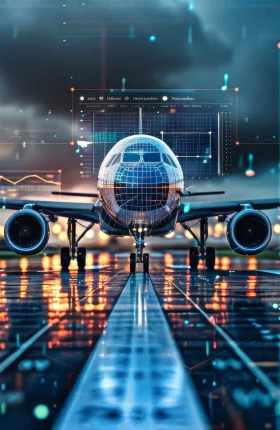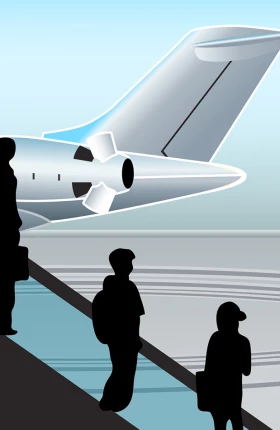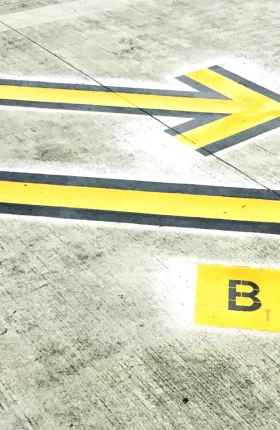Fuel-trading and hedging strategies are longstanding and familiar tools used by airlines to control costs. But they can be costly to execute, especially when prices are rising rapidly. Moreover, these strategies do not help airlines achieve their sustainability targets.
Airlines need new tools to control fuel costs. After labor, fuel is their largest operating expense, accounting for more than 20% of costs. Fuel prices have more than doubled in the past year, straining the profitability of a low-margin industry. But airlines can look beyond financial engineering and into the cockpits and cabins of their planes to find “behavioral hedges,” ways to lower costs through simple, inexpensive interventions—or “nudges”—that encourage better habits and decision making on the part of employees and passengers alike. Behavioral hedges can complement existing fuel hedges.
The airline industry is already onboard with nudges. For instance, Copenhagen Airport redesigned its signage to board passengers faster and more efficiently. In another experiment, Virgin Atlantic monitored pilots’ fuel usage before takeoff, in the air, and on the ground after landing. The airline estimates that during the study, which covered eight months and 40,000 flights, pilots cut fuel costs by $5.4 million and reduced carbon dioxide emissions by more than 21,500 metric tons.
Former pilot Simon Kinsey, vice president of flight operations and former interim COO of Brussels Airlines, draws inspiration from the success of the Virgin study. “We all have a part to play making aviation sustainable. Sometimes it’s hard to connect the small decisions we take with the aggregate impact they have. Airlines can help by experimenting with creative nudges to change behaviors within different populations. These need not be costly, and yet can have significant impact.”
So how can nudges reduce fuel consumption even further? The Virgin Atlantic experiment demonstrated that pilots have opportunities to reduce fuel consumption across the life cycle of a flight, from flight planning and predeparture preparation to in-flight operations and ground handling. As Virgin’s executive vice president of operations, Philip Maher, put it, "the experience highlighted the power of fairly simple, low-cost nudges to produce positive behaviors. It also demonstrated the importance of experimentation to determine what works and what doesn’t.”
Pilots are not the only people whose behavior affects fuel consumption. Nudges can influence three other sets of actors in reducing fuel consumption: dispatchers, cabin crew, and passengers. (See exhibit.)
Dispatchers
Dispatchers help ensure flight safety. One of their most important tasks is to determine, in coordination with pilots, how much discretionary fuel to load onto an aircraft as a safeguard against bad weather and other contingencies. Discretionary fuel load estimates can vary greatly by dispatcher and pilot. Understandably, many are risk averse, despite being highly analytical and having access to large amounts of data.
One low-cost, low-complexity nudge would be simplifying decision making by means of a manageable set of questions that guide estimates. Another would be breaking down barriers to “collaboration” with flight-planning systems powered by artificial intelligence to help dispatchers formulate responsible heuristics that guide decision making.
Despite its accuracy, AI technology is often met with resistance when employees feel that it reduces their decision-making autonomy. To counter mistrust, airlines could provide dispatchers with historical fuel averages for specific routes based on a flight’s date and time; this level of precision might appeal to their analytical mindset and evoke the “system 2" thinking described by behavioral psychologist Daniel Kahneman in Thinking, Fast and Slow. Similarly, postflight summaries comparing the estimates of individual dispatchers with those of the flight-planning system and with actual fuel consumption would build confidence in the use of AI and increase the “decision intelligence” of dispatchers. In an analogous pilot project in the shipping industry, crew members received weekly individualized fuel-saving targets based on prior performance. Combined with positive feedback, the targets nudged the crew to use less fuel.
Social-comparison nudges can also help counter resistance to AI. Monthly communications could feature local dispatchers who have reduced fuel loads by leveraging AI tools. Similarly, airlines could generate monthly or quarterly analytical summaries that highlight dispatchers whose flights’ fuel consumption came within 5% of estimates. Such interventions have worked to lower energy usage in the retail utilities industry; families that received bills that rated their use relative to similar households reduced consumption by 2%.
Pilots
Airlines can look beyond financial engineering to find simple, inexpensive interventions that encourage better habits and decision making on the part of employees and passengers alike.
At the gate, pilots can affect fuel consumption by connecting to ground power rather than running the plane’s auxiliary engines. They can taxi using a single engine, optimize flight speed to avoid fuel-wasting accelerations and decelerations, opt for reduced-power takeoffs, and make continuous-descent landings. Recently, Delta Air Lines’ Fuel Council implemented several procedural improvements, including behavioral nudges aimed at reducing annual fuel consumption by 11 million gallons.
Pilots have developed their own rituals and techniques over time that are difficult to change. Whether from inertia or skepticism regarding its impact, they may not choose the most fuel-efficient option. And while it’s true that the actions of a lone pilot on a single flight will have little effect, collectively these small decisions add up. A single-engine taxi, for example, may reduce fuel use by only 60 pounds; multiplied by all of an airline’s flights, however, the savings become significant. The goal is to help pilots understand the potential magnitude of their collective impact.
As skilled professionals who bear an enormous responsibility to protect human life, pilots may experience nudges as heavy-handed mandates rather than helpful suggestions. Educational and social nudges that appeal to their pride and sense of personal agency may therefore be more likely to influence behavior than “architectural” nudges, which alter the environment in which decisions are made.
For example, pilots who care about acting on climate change may be more receptive to a reduction in carbon emissions than to saving fuel. Airlines could give them a nudge by providing a summary of the overall annual reduction in carbon emissions resulting from the consistent adoption of fuel-saving behaviors. Or they could ask pilots to sign an annual “green” pledge to reduce their carbon emissions through eco-friendly decisions—an application of the behavioral theory that individuals generally act in line with their commitments.
Social-comparison nudges might also help. For instance, airlines could provide pilots with reports comparing their fuel savings with that of their peers. Although pilots might not be expected to welcome such nudges, in an experiment cited in John List’s The Voltage Effect: How to Make Good Ideas Great and Great Ideas Scale, 79% of pilots said they desired such initiatives while only 6% did not.
Cabin Crew
Pilots have opportunities to reduce fuel consumption across the life cycle of a flight, from flight planning and predeparture preparation to in-flight operations and ground handling.
Responsible for passenger safety and comfort in the air, cabin crews are the ultimate frequent fliers. How much they bring onboard—the personal items that they pack combined with what the airline requires them to carry on—can meaningfully affect fuel consumption. For example, United Airlines has saved hundreds of thousands of gallons of fuel a year by replacing 35-pound paper flight manuals with iPads.
To further reduce the weight of crew luggage, airlines could subsidize or give crew members extra-light suitcases, jackets, or water bottles. Similarly, they could provide crews with appealing food and beverage options in airport break rooms to reduce their temptation to pack heavy bags of food on multiday trips. These nudges are win-win-win. They increase fuel efficiency, provide perks, and improve the overall experience of employees.
Passengers
Passengers may be relatively passive participants in air travel, but small changes in their behaviors and choices can matter. In hot and sunny climates, closing the plane’s shades can reduce fuel consumption by delaying the start of the auxiliary engines needed for cooling. At the end of flights to such destinations, the cabin crew could ask passengers to draw their shades, as crews on Delta Air Lines do. Better yet, airlines could gamify the behavior by creating an image or cartoon that fully appears only when the shade is drawn. Gamified interventions are often low cost and impose no burden on passengers. At Amsterdam’s Schiphol Airport, realistic flies are etched into the base of urinals to provide a target. This simple intervention has reduced spillage by 80% and cleaning costs by 8%.
Airlines have traditionally tried to reduce luggage weight by increasing the price of checked bags and setting strict weight limits, but nonfinancial nudges could work by helping passengers understand how their decisions affect fuel consumption. For example, at check-in or at the time of booking, airlines could let passengers know the carbon emissions generated by each pound of luggage. Or passengers could earn additional frequent-flyer points or priority boarding for opting out of meal service or flying with only a carry-on bag.
Six Suggestions
While fuel is a commodity with prices set by market forces, its use can be managed efficiently through a series of human decisions and behavioral hedges. The following suggestions may nudge you to act on this low-cost, high-potential approach:
- Map out the end-to-end steps in the fuel consumption cycle and the key drivers of fuel usage.
- Analyze meaningful fuel-saving decisions made by key actors.
- Identify potential behavioral biases or barriers preventing fuel-saving behaviors.
- Get creative in devising nudges to drive decisions and actions in the right direction.
- Conduct small experiments to measure impact and refine interventions based on results.
- Roll out successful interventions in small pilots, continuing to measure impact and effectiveness.
Fuel economy is too important to be left to the financial engineers alone. Airlines can act now to complement traditional fuel-hedging strategies with simple behavioral hedges that save fuel and lower costs.







